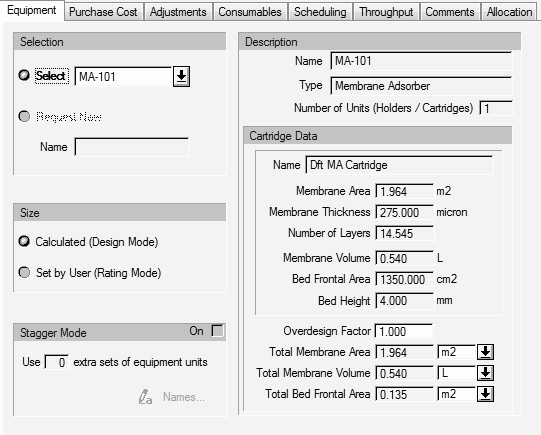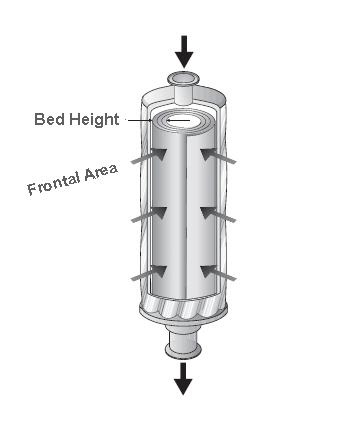

The following table shows the meaning of the variables appearing in this tab, as well as their default values and their generally acceptable range. Note that due to the manner by which the variables are used by the sizing and costing equations, the range of acceptable values may be further reduced.
|
Variable |
Default Value |
Range |
|
|
||
|
● Name (of Catridge) |
Dft MA Cartridge |
|
|
● Membrane Area (of Catridge) |
1.964 m2 |
Positive |
|
● Membrane Thickness (of Catridge) |
275.0 microns |
Positive |
|
● Number of Layers (of Catridge) |
14.545 |
Positive |
|
● Membrane Volume (of Catridge) |
0.540 L |
Positive |
|
● Bed Frontal Area (of Catridge) |
1350.0 cm2 |
Positive |
|
● Bed Height (of Catridge) |
4.0 mm |
Positive |
|
◙ Overdesign Factor |
1.0 |
Positive |
|
● Total Membrane Area |
1.964 m2 |
Positive |
|
● Total Membrane Volume |
0.540 L |
Positive |
|
● Total Bed Frontal Area |
0.135 m2 |
Positive |
Symbol Key: ○ User-specified value (always input); ● Calculated value (always output); ◙ Sometimes input, sometimes output
The Membrane Adsorber requires the use of an ‘Adsorption Membrane’ cartridge (a consumable). By default the selected consumable is a ‘Dft MA Cartridge’. For information on how to select the required consumable and additional consumables for the Membrane Adsorber, see Chromatography/Adsorption Equipment: Consumables tab. For information on the properties of an ‘Adsorption Membrane’ consumable type, see Consumable Properties Dialog: Adsorption Membrane Properties tab.
A schematic of a membrane adsorber’s geometry and feed flow pattern is shown in the figure below. The adsorbing membrane is wound around a reel to form a tubular bed consisting of multiple membrane layers. The membrane bed is then placed in a cylindrical catridge. The flow is from the top into the outside channel and then perpendicular through the membrane layers to the center of the bed and leaves the catridge at the outlet. For each new ‘Adsorption Membrane’ consumable added to the Consumables database, the user has to specify the membrane area (i.e., the total surface area of the membrane “sheet”), membrane thickness and number of membrane layers comprising the bed. Based on these values, the membrane volume, bed height (i.e., the “thickness” of the bed) and bed frontal area (i.e., the outer surface area of the bed) are calculated by the program. The membrane volume is computed as the membrane area times the membrane thickness. The bed height is set equal to the membrane thickness times the number of layers. Lastly, the bed frontal area can be estimated by either dividing the bed volume by the bed height or the membrane area by the number of layers.

In Design Mode, the membrane volume demand is specified by the MA loading operations carried out as part of the (one or more) Membrane Adsorption unit procedures hosted by the equipment resource. The program will size the equipment based on the largest demand on membrane volume amongst all MA loading operations executed in the equipment. Once the largest membrane volume demand is determined, it is multiplied by the overdesign factor to determine the total membrane volume requirement. If this exceeds the membrane volume of a single unit, then the program will assume multiple identical units that are operated in parallel.
In Rating Mode, the user specifies the Number of Units. If the membrane is undersized for its separation task, the program displays a warning advising the user to increase the number of cycles per batch or use a larger MA Cartridge.
The equipment purchase cost is a function of membrane volume and material of construction. The built-in equipment purchase cost is based on vendor data for an equipment containing the default consumable.
For more information on this equipment, see Membrane Adsorber (MA).
For information on the left-hand and top right-hand side variables and options, see Equipment Data Dialog: Equipment tab.